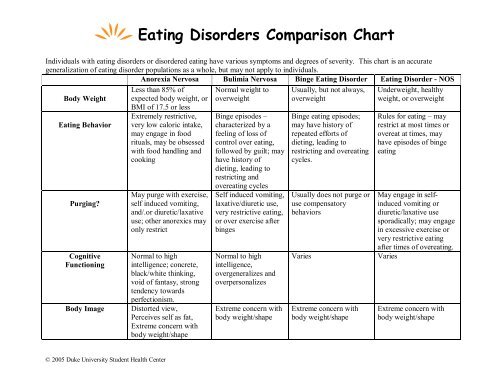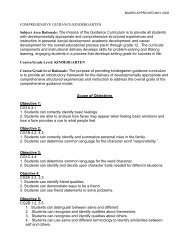Eating Disorders Comparison Chart
Eating Disorders Comparison Chart
Eating Disorders Comparison Chart
Create successful ePaper yourself
Turn your PDF publications into a flip-book with our unique Google optimized e-Paper software.
<strong>Eating</strong> <strong>Disorders</strong> <strong>Comparison</strong> <strong>Chart</strong><br />
Individuals with eating disorders or disordered eating have various symptoms and degrees of severity. This chart is an accurate<br />
generalization of eating disorder populations as a whole, but may not apply to individuals.<br />
Anorexia Nervosa Bulimia Nervosa Binge <strong>Eating</strong> Disorder <strong>Eating</strong> Disorder NOS<br />
Body Weight<br />
<strong>Eating</strong> Behavior<br />
Purging?<br />
Cognitive<br />
Functioning<br />
Body Image<br />
Less than 85% of<br />
expected body weight, or<br />
BMI of 17.5 or less<br />
Extremely restrictive,<br />
very low caloric intake,<br />
may engage in food<br />
rituals, may be obsessed<br />
with food handling and<br />
cooking<br />
May purge with exercise,<br />
self induced vomiting,<br />
and/.or diuretic/laxative<br />
use; other anorexics may<br />
only restrict<br />
Normal to high<br />
intelligence; concrete,<br />
black/white thinking,<br />
void of fantasy, strong<br />
tendency towards<br />
perfectionism.<br />
Distorted view,<br />
Perceives self as fat,<br />
Extreme concern with<br />
body weight/shape<br />
Normal weight to<br />
overweight<br />
Binge episodes –<br />
characterized by a<br />
feeling of loss of<br />
control over eating,<br />
followed by guilt; may<br />
have history of<br />
dieting, leading to<br />
restricting and<br />
overeating cycles<br />
Self induced vomiting,<br />
laxative/diuretic use,<br />
very restrictive eating,<br />
or over exercise after<br />
binges<br />
Normal to high<br />
intelligence,<br />
overgeneralizes and<br />
overpersonalizes<br />
Extreme concern with<br />
body weight/shape<br />
Usually, but not always,<br />
overweight<br />
Binge eating episodes;<br />
may have history of<br />
repeated efforts of<br />
dieting, leading to<br />
restricting and overeating<br />
cycles.<br />
Usually does not purge or<br />
use compensatory<br />
behaviors<br />
Varies<br />
Extreme concern with<br />
body weight/shape<br />
Underweight, healthy<br />
weight, or overweight<br />
Rules for eating – may<br />
restrict at most times or<br />
overeat at times, may<br />
have episodes of binge<br />
eating<br />
May engage in selfinduced<br />
vomiting or<br />
diuretic/laxative use<br />
sporadically; may engage<br />
in excessive exercise or<br />
very restrictive eating<br />
after times of overeating.<br />
Varies<br />
Extreme concern with<br />
body weight/shape<br />
© 2005 Duke University Student Health Center
<strong>Eating</strong> <strong>Disorders</strong> <strong>Comparison</strong> <strong>Chart</strong><br />
Physical Symptoms<br />
Psychological<br />
Symptoms<br />
Health Consequences<br />
Social Relationships<br />
Anorexia Nervosa Bulimia Nervosa Binge <strong>Eating</strong> Disorder <strong>Eating</strong> Disorder NOS<br />
Weight loss, amenorrhea, May gain weight, sore Weight gain,<br />
Weight loss or weight<br />
cold hands and feet, slow throat, nausea, gastrointestinal<br />
gain, gastrointestinal<br />
heart rate, low blood stomach cramps, symptoms, joint pain symptoms, fatigue, other<br />
pressure, gastrointestinal fainting spells,<br />
symptoms will depend on<br />
symptoms, wasted gastrointestinal<br />
specific behaviors.<br />
muscles, dry, brittle hair symptoms, esophageal<br />
and skin, lanugo (downy bleeds, swollen<br />
hair on body)<br />
glands, dehydration,<br />
Denial that there is a<br />
problem, intense fear of<br />
becoming fat or loosing<br />
control, depressed mood,<br />
may appear unemotional<br />
or have flat affect, may<br />
exhibit obsessive<br />
compulsive behaviors;<br />
may have history of<br />
abuse<br />
Loss of bone mass<br />
(osteoporosis),<br />
dehydration (can result<br />
in kidney failure), risk of<br />
heart failure, infertility<br />
Social withdrawal, not<br />
connected with people,<br />
excuses to not eat with<br />
others, decreased interest<br />
in sex<br />
discoloration of teeth<br />
Guilt, anxiety after<br />
binges, may exhibit<br />
signs of lack of<br />
control, self<br />
destructive behavior –<br />
sexual promiscuity,<br />
stealing, etc; may<br />
have history of sexual,<br />
physical, or verbal<br />
abuse<br />
Electrolyte imbalance<br />
can lead to heart<br />
failure, dehydration,<br />
tooth decay, gastric<br />
rupture<br />
Withdrawn at times,<br />
but able to form close<br />
relationships<br />
Feelings of shame or selfhatred,<br />
individual may<br />
struggle with anxiety,<br />
depression and loneliness<br />
High blood pressure, high<br />
cholesterol levels, heart<br />
disease, diabetes,<br />
gallbladder disease, joint<br />
problems<br />
May be withdrawn at<br />
times, but able to form<br />
close relationships,<br />
interpersonal sensitivity<br />
Focus on food, body, and<br />
exercise<br />
Depending on behavior,<br />
can be a combination of<br />
other eating disorder<br />
health consequences<br />
Varies – disordered eating<br />
may effect social<br />
relationships; person may<br />
become withdrawn<br />
© 2005 Duke University Student Health Center
<strong>Eating</strong> <strong>Disorders</strong> <strong>Comparison</strong> <strong>Chart</strong><br />
Gender Incidence<br />
LGBT Population<br />
Racial Minority<br />
Populations<br />
Anorexia Nervosa Bulimia Nervosa Binge <strong>Eating</strong> Disorder EDNOS<br />
9095% of people 80% of people 60% diagnosed are<br />
diagnosed are female; diagnosed are female, female, 40% are male<br />
105% are male; 20% are male;<br />
male;<br />
5075% diagnosed are<br />
female, 5025% are<br />
Increased risk of anorexia nervosa and bulimia nervosa among homosexual males, compared to<br />
heterosexual males 1 . Studies show that there is no significant difference in body dissatisfaction between<br />
lesbian and heterosexual females (it was once thought that lesbians were protected), but gay men have<br />
more body dissatisfaction than heterosexual men 2,3 . Studies show that 1042% of men suffering from<br />
eating disorders are homosexual, compared to approximately 6% of males are homosexual in general<br />
population 4 .<br />
There are no exact statistics on the incidence of eating disorders among racial minorities, because<br />
historically studies have focused on white, females. However, recent studies indicate that African<br />
American women are more likely to engage in diuretic/laxative use and fasting to control weight than<br />
Caucasian women 5 . African American girls consistently score higher than white girls on <strong>Eating</strong><br />
Disorder Inventory Scales measuring features associated with eating disorder except body<br />
dissatisfaction and drive for thinness. Studies show that African American women may be twice as<br />
likely to suffer from BED than Caucasian women 6 . Studies show that eating disorder incidence is<br />
increasing among all minority populations in the US and risk increases as a person assimilates to the<br />
dominate culture.<br />
Sources:<br />
1. Carlat, D., Camargo, C. Herzog, D. (1997). <strong>Eating</strong> <strong>Disorders</strong> in Males: A Reports on 135 Patients. American Journal of Psychiatry 154, (8), 1127<br />
1132.<br />
2. Myers, A. Taub, J. Morris, J. Rothblum, E. (1999). Beauty Mandates and the Appearance of Obsession: Are Lesbian and Bisexual Women Better<br />
Off? Journal of Lesbian Studies, 3, (4), 1526.<br />
3. Yelland, C. Tiggermann, M. (2003) “Muscularity and the gay ideal: body dissatisfaction and disordered eating in homosexual men.” <strong>Eating</strong><br />
Behaviors, 4, 107116.<br />
4. Russell, C. Keel P. (2002) Homosexuality as a Specific Risk Factor For <strong>Eating</strong> <strong>Disorders</strong> in Men. International Journal of <strong>Eating</strong> <strong>Disorders</strong>, 31,<br />
300306.<br />
5. StriegalMoore, R., Wilfley, D., Pike K., Dohm, F., Fairburn, C. (2000) Recurrent Binge <strong>Eating</strong> in Black American Women. Archives of Family<br />
Medicine, 9, 8387.<br />
6. StriegalMoore, R. Schreiber, G. Lo, A. Crawford, P. Obarzanek, E. Rodin, J. <strong>Eating</strong> Disorder Symptoms in a Coholt of 1116 Year Old Black and<br />
White Girls: The NHLBI Growth and Health Study. International Journal of <strong>Eating</strong> <strong>Disorders</strong>, 27, (1), 4966.<br />
© 2005 Duke University Student Health Center






